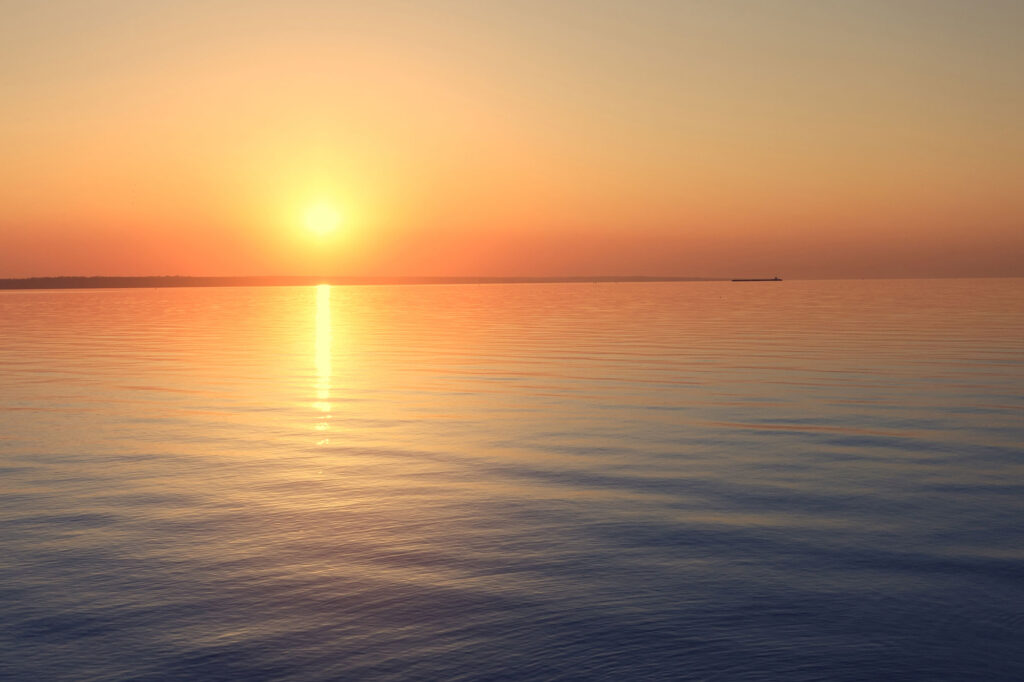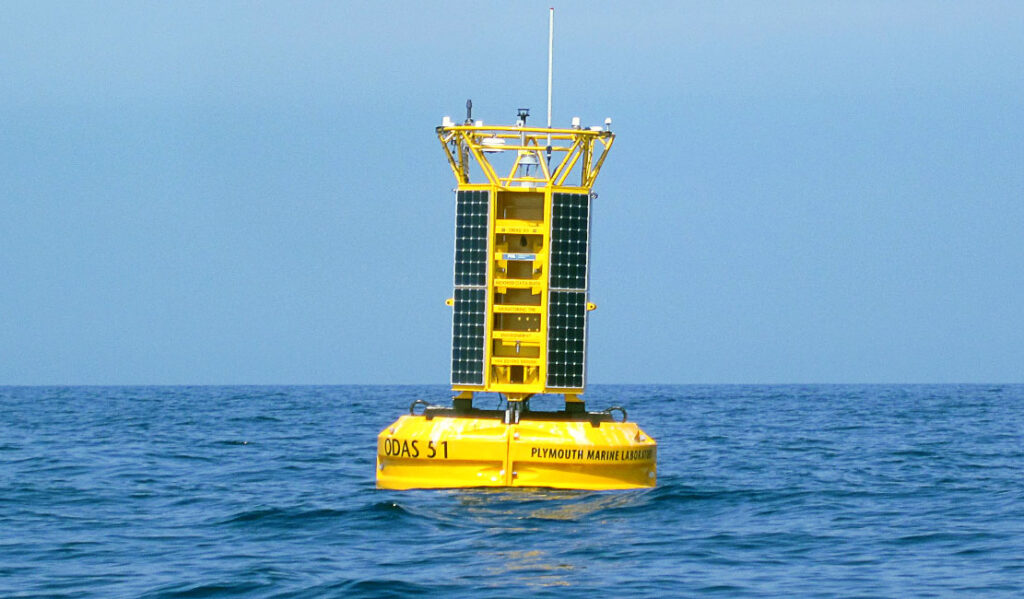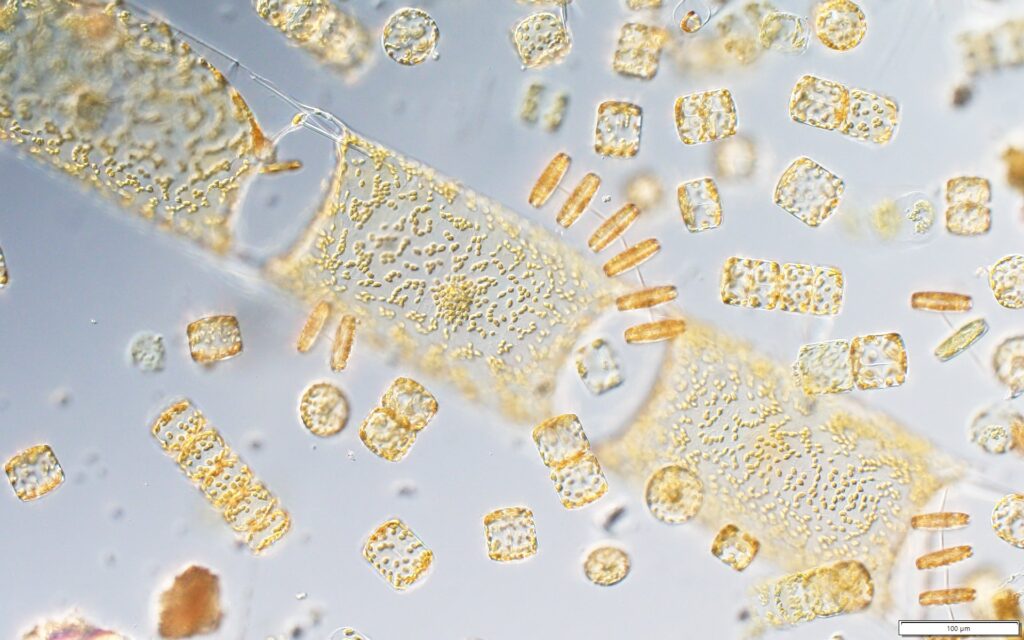Story
Update from the lab: marine heatwave conditions continue to escalate in UK waters
28 May 2025
Our data from the western English Channel has shown almost continuous marine heatwave conditions for the past two years, and, with the latest unusually warm spell of weather across the UK, ocean surface temperatures are further increasing. Our scientists are monitoring the situation, and in this article explain what is happening, why, and the effects of marine heat waves on life below, and ultimately us all.

Plymouth Marine Laboratory and the Marine Biological Association have been monitoring conditions in the western English Channel for over a century – making it one of the most studied and best understood areas of the ocean in the world.
The data is collected as part of our ongoing work collecting data for the Western Channel Observatory, which began back in 1903.
Did you know? Data from the Western Channel Observatory is free and open-access >>
PML’s Professor Tim Smyth has led the NERC-funded Western Channel Observatory for over 20 years. He describes the long-term trends of ocean warming:
“The more than centennial dataset from the western English Channel shows that sea-surface temperatures have increased markedly within the past 40 years, at a rate of around 0.6°C per decade. Furthermore, warm anomalies have been increasingly common, and cold anomalies increasingly rare.”
“The current definitions of Marine Heat Waves (MHW) were described by Hobday et al., (2018), the basic definition being that if the sea surface temperature is within the top 10% of those recorded for that particular day of the year, then a heatwave condition has been reached.”
“… marine heatwaves have increased in their frequency – with a cluster of them since 2010…”
“In the western English Channel, marine heatwaves have increased in their frequency – with a cluster of them since 2010 – and in recent years, has sustained almost continuous MHW conditions.”
“However, the depth resolution of the data also shows that at 50m – well below the top layer of the ocean (thermocline) – that temperatures have also increased markedly. The MHW is therefore not only a surface phenomenon.”
“We know the climate is changing due to human activity. The long-term trend shows that the ocean is warming, and this is already having effects on species and habitats. The frequency of marine heatwaves is also increasing – and these can have additional short-term impacts.”
Professor Smyth describes how PML are monitoring the latest UK marine heatwave, what is driving it, and the implications for us all:
“Throughout April and May 2025, we have been able to map and monitor the development of a marine heatwave via operational datasets derived from a combination of satellites, in situ observations and oceanographic models.”
“These datasets are now at a sufficient length to enable a climatological baseline to be constructed. This is crucial, as without sufficient longevity, departures from the long-term average are impossible to contextualise. Simply put, we would not know how severe and widespread a MHW would be without this.”
“Heatwave conditions really haven’t gone away at all for the past two or three years.”
“Our autonomous E1 scientific buoy, situated about 20 miles south of Plymouth has been tracking the UK Marine Heat Wave on an hourly basis. Currently the temperatures are 2 – 3 °C higher than average, and well above the 90th centile. “Heatwave” conditions really haven’t gone away at all for the past two or three years.”
Image caption: the E1 scientific buoy. Station E1 was originally founded by the International Council for the Exploration of the Seas (ICES) in 1902 as part of the English (hence “E” designation) observational effort. Professor Smyth says, ”What sets E1 apart is the near continuous nature of the time-series since then; the frequency of data collection (bi-weekly to monthly) and importantly depth resolution of the temperature and salinity record. This enables us to observe the entire water column (80 m deep at E1) and the seasonal progression of mixing and stratification (layering) of the ocean in that location.”
“As usual, these conditions are caused by combination of effects, but it basically boils down to the fact that more energy is being input during the day than is being lost at night. March 2025 was the sunniest March on record (since 1910) with the UK Met Office statistics showing there was around 185 hours of sunshine; April set new records for UK solar power generation with 12.2 GW being produced (current UK solar sector 18 GW).”
“May continued that trend, as there have been long periods of clear skies under atmospherically blocked conditions, i.e. persistent high-pressure areas over the UK. High pressure areas are also associated with relatively low wind speeds, which means that mixing of cooler deep-water temperatures is somewhat restricted.”
“During the spring, rapidly increasing daylength also means the time for energy-in (day) outweighs energy-out (night). It has also been notable that the spring plankton bloom was very early this year (during early March), which means the bloom finished relatively early and the surface waters became clearer, earlier. The conditions during May at E1 resembled those we would ordinarily associate with mid-summer, with the plankton bloom sitting deeper in the water. The clearer water would then allow sunlight to penetrate deeper within the water.”
Image caption: The microalgal plankton community sampled from L4 in May shows an increase in the species diversity of diatoms, including the oval shaped, chain-forming Thalassiosira spp. and the large rectangular Odontella sinsensis. Such appearances can possibly indicate the start of the Spring bloom. Image credit: Bryony Pearton / Plymouth Marine Laboratory.
Professor Smyth continues to explain how marine heat waves can affect us on land.
“Marine heatwaves can have an effect on the land temperatures, and this is particularly noticeable at night-time, when the land temperatures can be warmer around coastal areas then they would be otherwise.”
“… this has implications for the food web…”
“And, coming back to the plankton bloom, with the distribution of where plankton are in the water column more closely resembling that of summer than spring – this has implications for other parts of the food web. We are seeing increased incidence of species such as tuna and octopus – the latter have been reported to be taking from crab pots, in turn affecting the shellfish industry. Longer term, due to ocean warming, the distribution of species is expected to change, and this will have implications for the species we see in UK waters (and on our dinner tables!).”
Biological Oceanographer at PML, Professor Helen Findlay, further explains the impacts on ocean ecosystems:
“Temperature is hugely important in regulating biological processes, especially in the ocean where many creatures cannot regulate their own body temperature. These processes impact how species grow, develop, reproduce and interact to make up a healthy ecosystem.”
“As we see more frequent and longer marine heatwaves and overall increases in ocean temperature, some species will be able to cope and some won’t.”
“As we see more frequent and longer marine heatwaves and overall increases in ocean temperature, some species will be able to cope and some won’t. At an ecosystem level we are still trying to work out what these changes mean – as one species replacing another may seem okay, but they can have subtle differences in their life history, which can alter how the ecosystem functions.”
Marine and Climate Change Ecologist Professor Ana Queirós describes how some species organisms do not have the ability to escape the heatwave conditions:
“Unlike marine organisms such as fish, corals can’t move when the ocean around them experiences a heatwave. With many areas of ocean now undergoing seabed heatwaves, the impact can be terrible.”
“The outcome is more frequent seabed hypoxia (low oxygen) events, leading to die offs on the ocean floor.”
“More generally, ocean warming is also depriving marine life of vital oxygen and nutrients. Oxygen is less soluble in warmer waters, and since surface water warms up before water lower down, it also becomes less dense, making it harder for water at the top and bottom of the ocean to mix. Without this mixing, nutrients deposited at or near the seafloor struggle to make it back to surface waters, where they are needed by microorganisms such as phytoplankton that form base of the food web. In turn, oxygen from surface waters cannot reach the deeper layers of the ocean.”
“The outcome is more frequent seabed hypoxia (low oxygen) events, leading to die offs on the ocean floor. As well as the expansion of ‘oxygen minimum zones’, in which seafloor areas are depleted in oxygen for long periods.”
Professor Smyth concludes, reflecting on the likelihood of more marine heatwaves, and highlighting the importance of sustained long-term monitoring:
“Finally, can we expect more MHW into the future? It is clear from our century plus of measurements that currently MHW are occurring more frequently and that there appears to be an almost ‘continuous on’ state emerging. The intensity of MHW generally correlates well with persistent high-pressure areas remaining static over the UK in a blocked pattern, but it is still unclear whether or not this is a ‘new normal’, or just an episode within the general patterns of change within the UK seas.”
“It is only with regular, high-frequency and high-quality data that we can begin to contextualise marine heatwaves. What is clear from our sea temperature monitoring is that the MHW conditions have increased in frequency over the past 50 years, and extreme cold conditions have been relatively rarer in that same period. This is not just at the surface but is a feature of the entire water column.”
“It is critical that we maintain some of the longest time-series in the world…”
“It is critical that we maintain some of the longest time-series in the world at the regional and ocean basin scale, and at as high a frequency as possible. Otherwise, we will not be able to inform national and international policy on issues as broad but interrelated as the increased incidence of marine heatwaves, the intensification of ocean acidification and changes to plankton dynamics and impacts on biodiversity. Coupled to this, the continued development of our world-leading ecosystem modelling capability is essential if we are to predict and manage likely changes to the marine environment in the decades to come.”


